Socio-Spatial Analysis of Water Affordability at Small Scales: A Needs-Based Approach
Abstract
1. Introduction
1.1. Theoretical Framework
1.2. Water Poverty as an Affordability Problem: An Emerging Field of Study
2. Materials and Methods
2.1. Case Study: The Metropolitan Area of Barcelona (MAB)
2.2. Calculation of the Water Affordability Index at the Census Tract Level
- TWBA is the total amount of the bill (in EUR).
- WSF is the Water Supply Fee, including the Fixed Consumption Fee, the Variable Consumption Fee, and the Water Meter fee. The Fixed Consumption Fee depends on the number of water-using devices present in homes (taps, baths, toilets, etc.), and, in the case of ABEMCIA (the largest water company in the MAB) ranges from EUR 2.6/month (one tap, one toilet) to EUR 64/month, (households with several bathrooms and a garden and swimming pool). The Variable Consumption Fee includes the cost of the water consumed, which is priced according to a progressive block structure. On average, the fixed fee may represent up to 25 percent of the cost of the water supplied to households and a smaller proportion depending on the amount of the different taxes collected.
- SF is the Sewerage Fee.
- RWT is the Regional Water Tax. This tax also varies according to consumption blocks.
- VAT, which is generally 10% of the total bill except for the water meter fee, which is 21%.
- WAI is the Water Affordability Index (in %).
- TWBA is the total amount of the bill (in EUR).
- AHI is the Average Household Income (in EUR).
2.3. Spatial Autocorrelation Analyses
- is the number of spatial units (census tracts).
- is the sum of the spatial weights.
- and are the values of the variable at locations and , respectively.
- is the mean value of the variable across all locations.
- represents the spatial weigh between locations and .
3. Results
3.1. Global and Local Spatial Autocorrelation of WAI
3.2. Bivariate Correlations: WAI and Population at Risk of Poverty
3.3. WAI, Gender and Residents Born in Global South Countries
3.4. Bivariate Correlation: WAI and Percentage of Elderly and Underaged Population
3.5. Bivariate Correlation: WAI and Gini Index
4. Discussion
5. Conclusions
Author Contributions
Funding
Data Availability Statement
Conflicts of Interest
Appendix A
| Municipality | Total Population | Average Household Income (EUR/Year) | Supply Company | Average Essential Water Spending (EUR/Year) | Average WAI (%) | CTs with WAI Values Higher than MAB Average Values (%) | Population Living in CTs with WAI Values Higher than MAB Average Value (%) |
|---|---|---|---|---|---|---|---|
| MAB | 3,222,654 | 37,546 | - | 273.73 | 0.79 | 47 | 43.66 |
| Badalona | 218,538 | 31,745 | ABEMCIA | 251.20 | 0.84 | 59 | 55.30 |
| Badia Del Vallès | 13,387 | 27,367 | SOREA | 242.76 | 0.89 | 100 | 100 |
| Barberà Del Vallès | 32,745 | 35,670 | Aigües de Barberà * | 207.19 | 0.59 | 0 | 0 |
| Barcelona | 1,595,747 | 39,678 | ABEMCIA | 279.40 | 0.77 | 41 | 40.51 |
| Begues | 7065 | 51,243 | ABEMCIA | 338.47 | 0.66 | 0 | 0 |
| Castellbisbal | 12,359 | 39,231 | AICSA | 242.00 | 0.62 | 0 | 0 |
| Castelldefels | 65,711 | 45,091 | ABEMCIA | 320.88 | 0.78 | 50 | 42.98 |
| Cerdanyola Del Vallès | 56,693 | 40,866 | ABEMCIA | 268.58 | 0.70 | 27 | 26.27 |
| Cervelló | 8837 | 43,271 | SOREA | 298.29 | 0.69 | 0 | 0 |
| Corbera De Llobregat | 14,525 | 43,474 | SOREA | 418.64 | 0.99 | 91 | 93.08 |
| Cornellà Del Llobregat | 87,898 | 32,062 | ABEMCIA | 267.69 | 0.86 | 67 | 55.57 |
| Esplugues De Llobregat | 46,194 | 43,493 | ABEMCIA | 272.39 | 0.70 | 28 | 29.79 |
| Gavà | 46,557 | 36,683 | ABEMCIA | 284.87 | 0.80 | 61 | 53.80 |
| Hospitalet De Llobregat | 262,365 | 30,249 | ABEMCIA | 270.93 | 0.92 | 77 | 76.83 |
| La Palma De Cervelló | 2917 | 41,991 | ACAT | 251.47 | 0.60 | 0 | 0 |
| Molins De Rei | 25,795 | 39,164 | AQUALIA | 201.10 | 0.52 | 0 | 0 |
| Montcada I Reixac | 35,851 | 33,440 | ABEMCIA | 273.27 | 0.84 | 50 | 50.12 |
| Montgat | 11,970 | 38,078 | ABEMCIA | 286.35 | 0.76 | 25 | 26.69 |
| Pallejà | 11,275 | 42,475 | ABEMCIA | 277.40 | 0.67 | 0 | 0 |
| El Papiol | 4131 | 39,581 | ABEMCIA | 273.53 | 0.70 | 0 | 0 |
| El Prat De Llobregat | 63,867 | 34,337 | Aigües del Prat * | 199.98 | 0.60 | 5 | 3.95 |
| Ripollet | 38,561 | 31,763 | SOREA | 190.53 | 0.61 | 0 | 0 |
| Sant Adrià De Besòs | 36,745 | 28,854 | ABEMCIA | 279.49 | 1.03 | 79 | 73.04 |
| Sant Andreu De La Barca | 27,183 | 35,553 | AQUALIA | 211.46 | 0.60 | 0 | 0 |
| Sant Boi De Llobregat | 82,725 | 33,671 | ABEMCIA | 269.39 | 0.82 | 54 | 50.47 |
| Sant Climent De Llobregat | 4107 | 40,511 | ABEMCIA | 322.62 | 0.80 | 50 | 46.72 |
| Sant Cugat Del Vallès | 88,966 | 61,718 | SOREA | 323.68 | 0.56 | 10 | 5.83 |
| Sant Feliu De Llobregat | 44,430 | 37,825 | ABEMCIA | 270.76 | 0.74 | 40 | 30.43 |
| Sant Joan Despí | 33,892 | 40,022 | ABEMCIA | 272.36 | 0.70 | 36 | 28.22 |
| Sant Just Desvern | 17,287 | 60,551 | ABEMCIA | 268.13 | 0.48 | 11 | 5.32 |
| Santa Coloma De Cervelló | 8093 | 43,866 | ABEMCIA | 291.09 | 0.67 | 0 | 0 |
| Santa Coloma De Gramanet | 117,934 | 28,497 | ABEMCIA | 280.73 | 1.01 | 93 | 92.36 |
| Sant Vicenç Dels Horts | 27,681 | 34,501 | SVH | 181.39 | 0.53 | 0 | 0 |
| Tiana | 8716 | 56,547 | SOREA | 272.95 | 0.49 | 0 | 0 |
| Torrelles De Llobregat | 5978 | 42,174 | ABEMCIA | 323.06 | 0.77 | 50 | 41.45 |
| Viladecans | 66,144 | 35,706 | ABEMCIA | 276.96 | 0.79 | 53 | 49.47 |
References
- United Nations General Assembly (UN). The Human Right to Water and Sanitation: Resolution/Adopted by the General Assembly. Available online: https://www.refworld.org/legal/resolution/unga/2010/en/76535 (accessed on 22 February 2024).
- Langford, M. The United Nations Concept of Water as a Human Right: A New Paradigm for Old Problems? Int. J. Water Resour. Dev. 2005, 21, 273–282. [Google Scholar] [CrossRef]
- Anand, P.B. Right to water and access to water: An assessment. J. Int. Dev. 2007, 19, 511–526. [Google Scholar] [CrossRef]
- Pérez-Foguet, A. Broadening the Water Affordability Approach to Monitor the Human Right to Water. Cities 2023, 143, 104573. [Google Scholar] [CrossRef]
- United Nations General Assembly (UN). Transforming Our World: The 2030 Agenda for Sustainable Development. Available online: https://www.refworld.org/legal/resolution/unga/2015/en/111816 (accessed on 15 July 2023).
- Meehan, K.; Jepson, W.; Harris, L.M.; Wutich, A.; Beresford, M.; Fencl, A.; London, J.; Pierce, G.; Radonic, L.; Wells, C.; et al. Exposing the Myths of Household Water Insecurity in the Global North: A Critical Review. WIREs Water 2020, 7, e1486. [Google Scholar] [CrossRef]
- Ezbakhe, F.; Giné-Garriga, R.; Pérez-Foguet, A. Leaving No One behind: Evaluating Access to Water, Sanitation and Hygiene for Vulnerable and Marginalized Groups. Sci. Total Environ. 2019, 683, 537–546. [Google Scholar] [CrossRef] [PubMed]
- Yoon, H.; Domene, E.; Sauri, D. Assessing Affordability as Water Poverty in Metropolitan Barcelona. Local Environ. 2021, 26, 1330–1345. [Google Scholar] [CrossRef]
- Martins, R.; Quintal, C.; Cruz, L.; Barata, E. Water Affordability Issues in Developed Countries—The Relevance of Micro Approaches. Util. Policy 2016, 43, 117–123. [Google Scholar] [CrossRef]
- Vanhille, J.; Goedemé, T.; Penne, T.; Van Thielen, L.; Storms, B. Measuring Water Affordability in Developed Economies. The Added Value of a Needs-Based Approach. J. Environ. Manag. 2018, 217, 611–620. [Google Scholar] [CrossRef]
- Goddard, J.J. Measuring Drinking Water Affordability and Sustainability; UC Berkeley: Berkeley, CA, USA, 2019. [Google Scholar]
- Sullivan, C.; Meigh, J. Considering the Water Poverty Index in the Context of Poverty Alleviation. Water Policy 2003, 5, 513–528. [Google Scholar] [CrossRef]
- Goddard, J.J.; Ray, I.; Balazs, C. Water Affordability and Human Right to Water Implications in California. PLoS ONE 2021, 16, e0245237. [Google Scholar] [CrossRef]
- Petrova, S.; Simcock, N. Gender and Energy: Domestic Inequities Reconsidered. Soc. Cult. Geogr. 2021, 22, 849–867. [Google Scholar] [CrossRef]
- Middlemiss, L. Who Is Vulnerable to Energy Poverty in the Global North, and What Is Their Experience? WIREs Energy Environ. 2022, 11, e455. [Google Scholar] [CrossRef]
- Oliveras, L.; Artazcoz, L.; Borrell, C.; Palència, L.; López, M.J.; Gotsens, M.; Peralta, A.; Marí-Dell’Olmo, M. The Association of Energy Poverty with Health, Health Care Utilisation and Medication Use in Southern Europe. SSM-Popul. Health 2020, 12, 100665. [Google Scholar] [CrossRef] [PubMed]
- Galvin, R. Letting the Gini out of the Fuel Poverty Bottle? Correlating Cold Homes and Income Inequality in European Union Countries. Energy Res. Soc. Sci. 2019, 58, 101255. [Google Scholar] [CrossRef]
- Fagundes, T.S.; Marques, R.C.; Malheiros, T. Water Affordability Analysis: A Critical Literature Review. AQUA-Water Infrastruct. Ecosyst. Soc. 2023, 72, 1431–1445. [Google Scholar] [CrossRef]
- Teodoro, M.P. Measuring Household Affordability for Water and Sewer Utilities. J. AWWA 2018, 110, 13–24. [Google Scholar] [CrossRef]
- Teodoro, M.P.; Saywitz, R.R. Water and Sewer Affordability in the United States: A 2019 Update. AWWA Water Sci. 2020, 2, e1176. [Google Scholar] [CrossRef]
- Mack, E.A.; Wrase, S. A Burgeoning Crisis? A Nationwide Assessment of the Geography of Water Affordability in the United States. PLoS ONE 2017, 12, e0169488. [Google Scholar] [CrossRef] [PubMed]
- Bradshaw, J.; Huby, M. Water Poverty in England and Wales. J. Poverty Soc. Justice 2013, 21, 137–148. [Google Scholar] [CrossRef]
- Reynaud, A. Assessing the Impact of Public Regulation and Private Participation on Water Affordability for Poor Households: An Empirical Investigation of the French Case; LERNA, University of Toulouse: Toulouse, France, 2006. [Google Scholar]
- Miniaci, R.; Scarpa, C.; Valbonesi, P. Measuring the Affordability of Basic Public Utility Services in Italy. G. Degli Econ. Ann. Econ. 2008, 67, 185–230. [Google Scholar]
- March, H.; Garcia, X.; Domene, E.; Saurí, D. Tap Water, Bottled Water or In-Home Water Treatment Systems: Insights on Household Perceptions and Choices. Water 2020, 12, 1310. [Google Scholar] [CrossRef]
- March, H.; Saurí, D. When Sustainable May Not Mean Just: A Critical Interpretation of Urban Water Consumption Decline in Barcelona. Local Environ. 2017, 22, 523–535. [Google Scholar] [CrossRef]
- Domene, E.; Saurí, D. Urbanisation and Water Consumption: Influencing Factors in the Metropolitan Region of Barcelona. Urban Stud. 2006, 43, 1605–1623. [Google Scholar] [CrossRef]
- Yoon, H.; Saurí, D. ‘No More Thirst, Cold, or Darkness!’—Social Movements, Households, and the Coproduction of Knowledge on Water and Energy Vulnerability in Barcelona, Spain. Energy Res. Soc. Sci. 2019, 58, 101276. [Google Scholar] [CrossRef]
- Fankhauser, S.; Tepic, S. Can Poor Consumers Pay for Energy and Water? An Affordability Analysis for Transition Countries. Energy Policy 2007, 35, 1038–1049. [Google Scholar] [CrossRef]
- Smets, H. Quantifying the Affordability Standard: A Comparative Approach. In The Human Right to Water: Theory, Practice and Prospects; Russell, A.F.S., Langford, M., Eds.; Cambridge University Press: Cambridge, UK, 2017; pp. 225–275. ISBN 978-0-511-86260-1. [Google Scholar]
- Domene, E.; Garcia, X.; Garcia, M. La Pobresa Hídrica i Energètica a L’àrea Metropolitana de Barcelona; Institut Metropoli: Barcelona, Spain, 2018. [Google Scholar]
- National Statistical Institute of Spain (INE); Méndez Martín, J.M. The Spanish Survey of Living Conditions (ES-SILC). Characteristics and Methodological Development. Span. J. Stat. 2019, 1, 41–56. [Google Scholar] [CrossRef]
- Gleick, P.H. Basic Water Requirements for Human Activities: Meeting Basic Needs. Water Int. 1996, 21, 83–92. [Google Scholar] [CrossRef]
- García-Valiñas, M.A.; Martínez-Espiñeira, R.; González-Gómez, F. Affordability of Residential Water Tariffs: Alternative Measurement and Explanatory Factors in Southern Spain. J. Environ. Manag. 2010, 91, 2696–2706. [Google Scholar] [CrossRef]
- Bartram, J.; Howard, G. 14—Drinking-Water Standards for the Developing World. In Handbook of Water and Wastewater Microbiology; Mara, D., Horan, N., Eds.; Academic Press: London, UK, 2003; pp. 221–240. ISBN 978-0-12-470100-7. [Google Scholar]
- Fernández Maíllo, G. VIII Informe Sobre Exclusión y Desarrollo Social en España 2019; Fundación FOESSA Cáritas española editores: Madrid, Spain, 2019; ISBN 978-84-8440-772-0. [Google Scholar]
- Oficina de los Consumidores (OCU). Precio del Agua en España. Available online: https://www.ocu.org/alimentacion/agua/informe/el-precio-del-agua (accessed on 5 December 2023).
- Porcel, S. Desigualdad Social y Segregación Residencial: Una Relación Compleja; Fundación Foessa: Madrid, Spain, 2020; ISBN 978-84-8440-823-9. [Google Scholar]
- Institut Metròpoli (IERMB). La Metròpoli (Post)-COVID: Impactes, Escenaris i Reptes. (Post-COVID Metropolis: Impacts, Scenarios and Challenges). Anuari Metropolità de Barcelona 2020. Available online: https://www.institutmetropoli.cat/ca/anuari/metropoli-post-covid-impactes-escenaris-reptes/ (accessed on 12 November 2023).
- Institut Metròpoli (IERMB). Cap a la Metròpoli 2030. Reptes Emergents, Coneixements Innovadors. (Towards the Metropolis 2030. Emerging Challenges, Innovative Knowledge). Anuari Metropolità de Barcelona 2021. Available online: https://www.institutmetropoli.cat/ca/anuari/anuari-2021/ (accessed on 7 January 2024).
- Agència Catalana de l’Aigua (ACA). Preu per Municipis i Evolució (Municipal Water Prices and Trends). Available online: http://aca.gencat.cat/ca/laca/observatori-del-preu-de-laigua/Preu-per-municipis-i-evolucio/ (accessed on 9 February 2024).
- Eurostat Database General and Regional Statistics. Available online: https://ec.europa.eu/eurostat/data/database (accessed on 7 January 2024).
- Instituto Nacional de Estadística (INE). (National Statistics Institute) Censo de Población y Viviendas 2021 (Populations and Housing Census 2021). Available online: https://www.ine.es/dynt3/inebase/es/index.htm?padre=9805&capsel=9809 (accessed on 15 February 2024).
- Anselin, L.; Syabri, I.; Kho, Y. GeoDa: An Introduction to Spatial Data Analysis. In Handbook of Applied Spatial Analysis: Software Tools, Methods and Applications; Fischer, M.M., Getis, A., Eds.; Springer: Berlin/Heidelberg, Germany, 2010; pp. 73–89. ISBN 978-3-642-03647-7. [Google Scholar]
- Anselin, L. An Introduction to Spatial Data Science with GeoDa: Volume 1: Exploring Spatial Data; Chapman and Hall/CRC: New York, NY, USA, 2024; ISBN 978-1-00-327491-9. [Google Scholar]
- Benito, B.; Guillamón, M.-D.; Ríos, A.-M. Public Management Versus Private Management in the Provision of Drinking Water: What Is the Cheapest? Lex Localis-J. Local Self-Gov. 2018, 16, 271–292. [Google Scholar] [CrossRef]
- Porcher, S.; Saussier, S. Public Versus Private Management in Water Public Services: Taking Stock, Looking Ahead. SSRN Electron. J. 2018, 64, 4–31. [Google Scholar] [CrossRef]
- Tarifas de Suministro—Web Oficial—La Gestió Responsible. Available online: https://www.aiguesdebarcelona.cat/es/servicio-agua/factura-y-tarifas-agua/tarifas-de-suministro (accessed on 15 April 2024).
- Gutiérrez, A.; Delclòs, X. The Uneven Distribution of Evictions as New Evidence of Urban Inequality: A Spatial Analysis Approach in Two Catalan Cities. Cities 2016, 56, 101–108. [Google Scholar] [CrossRef]
- Gaber, N.; Silva, A.; Lewis-Patrick, M.; Kutil, E.; Taylor, D.; Bouier, R. Water Insecurity and Psychosocial Distress: Case Study of the Detroit Water Shutoffs. J. Public Health 2021, 43, 839–845. [Google Scholar] [CrossRef] [PubMed]
- Anguelovski, I.; Connolly, J.J.T.; Masip, L.; Pearsall, H. Assessing Green Gentrification in Historically Disenfranchised Neighborhoods: A Longitudinal and Spatial Analysis of Barcelona. Urban Geogr. 2018, 39, 458–491. [Google Scholar] [CrossRef]

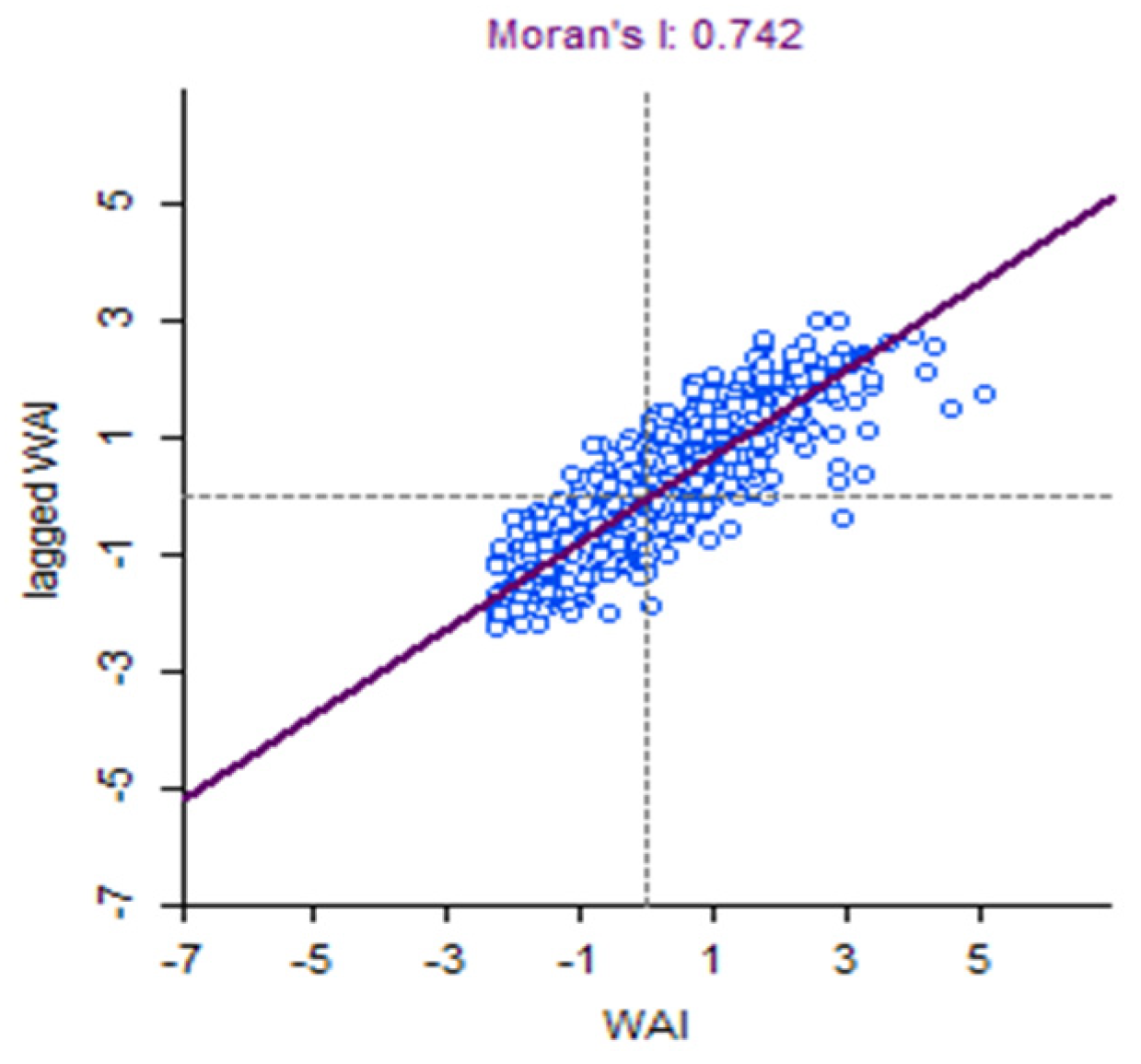
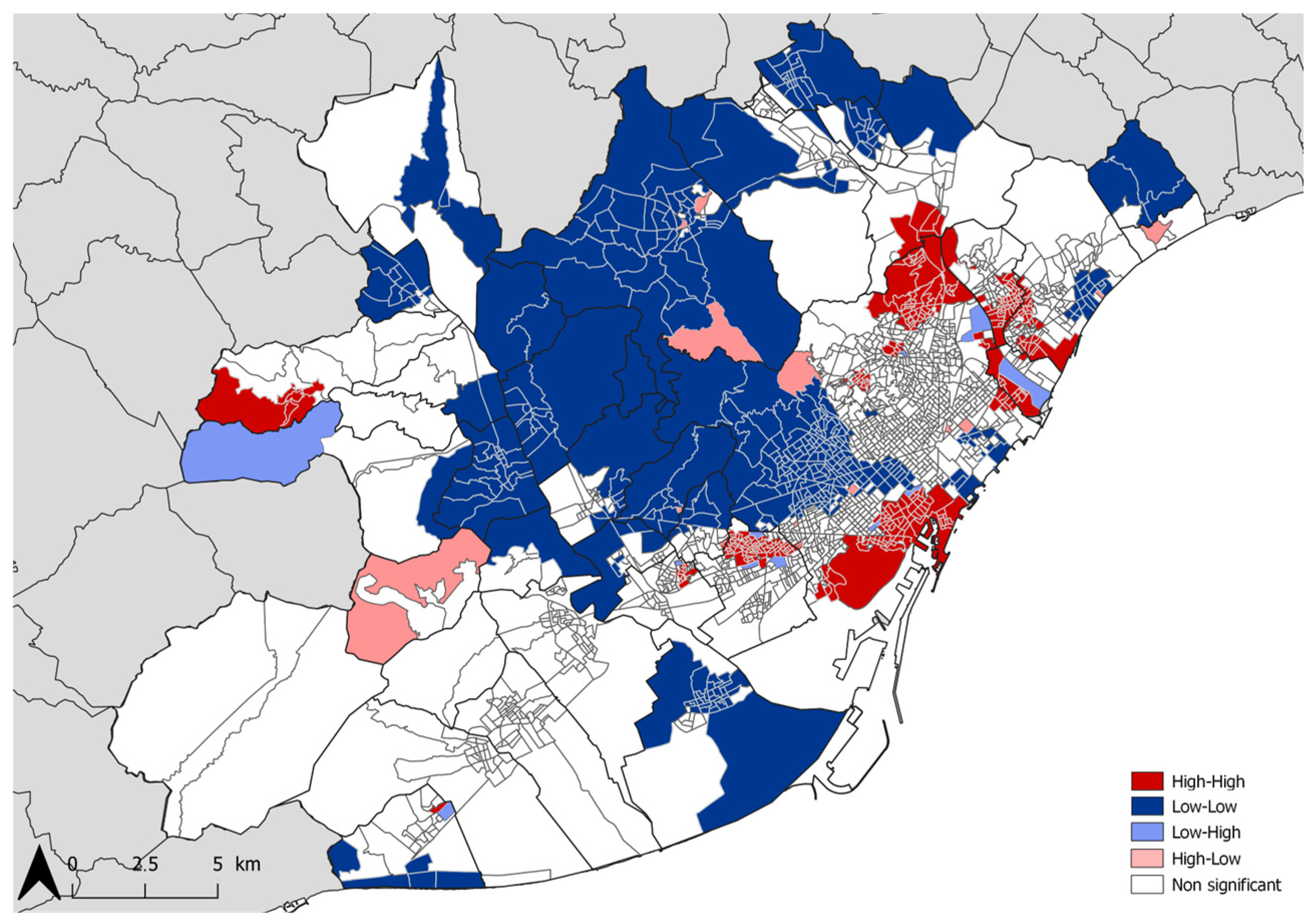
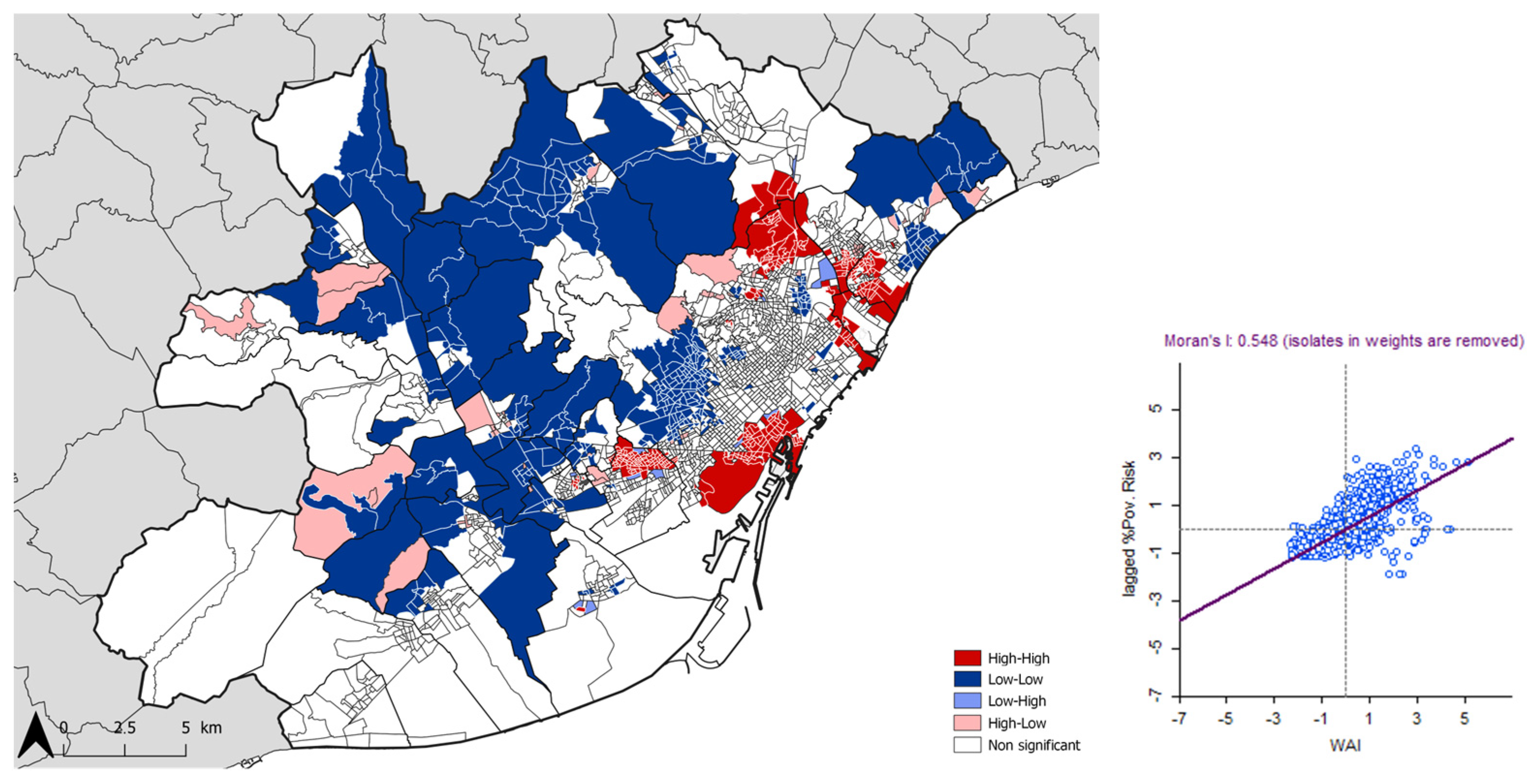

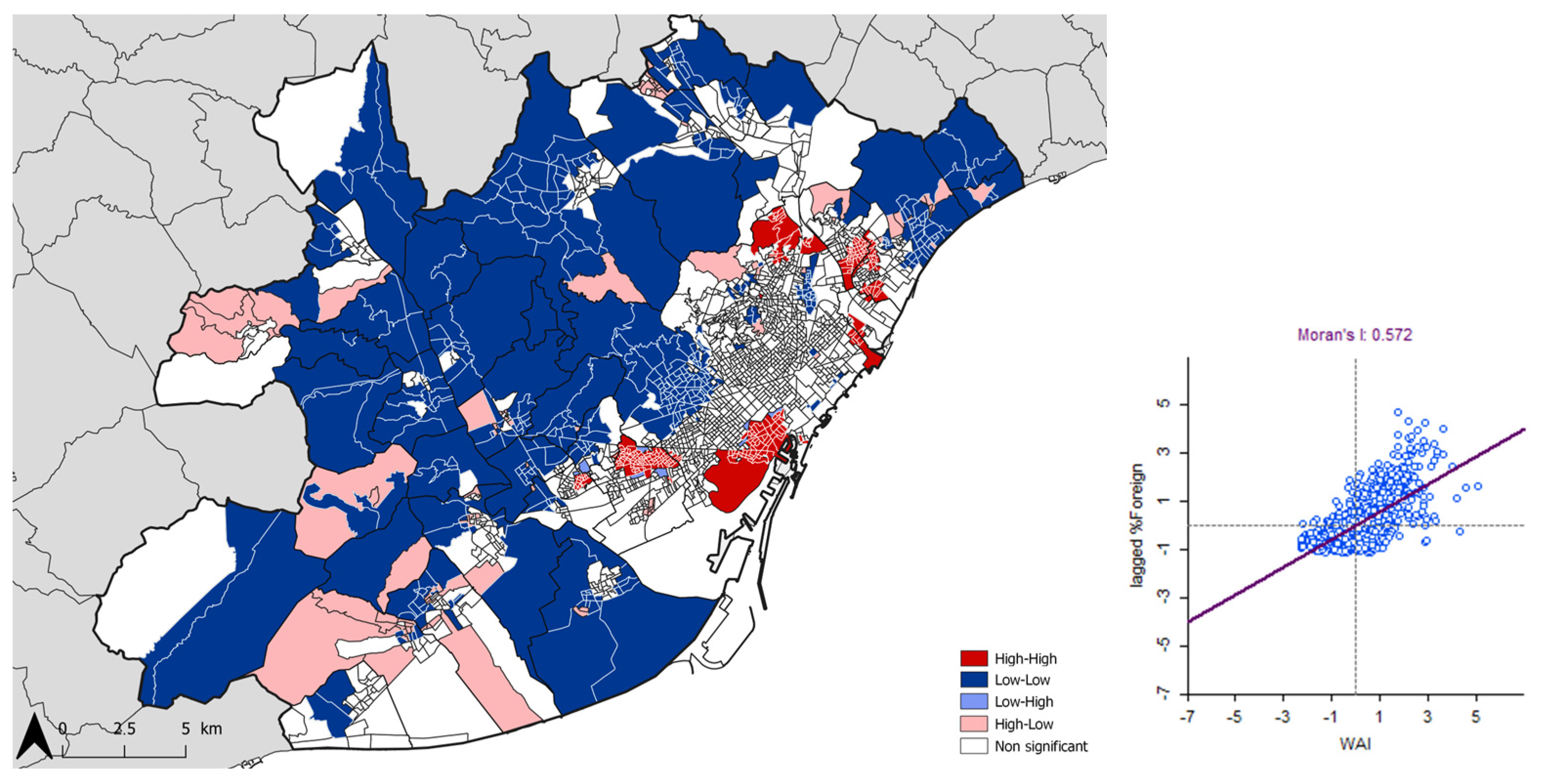
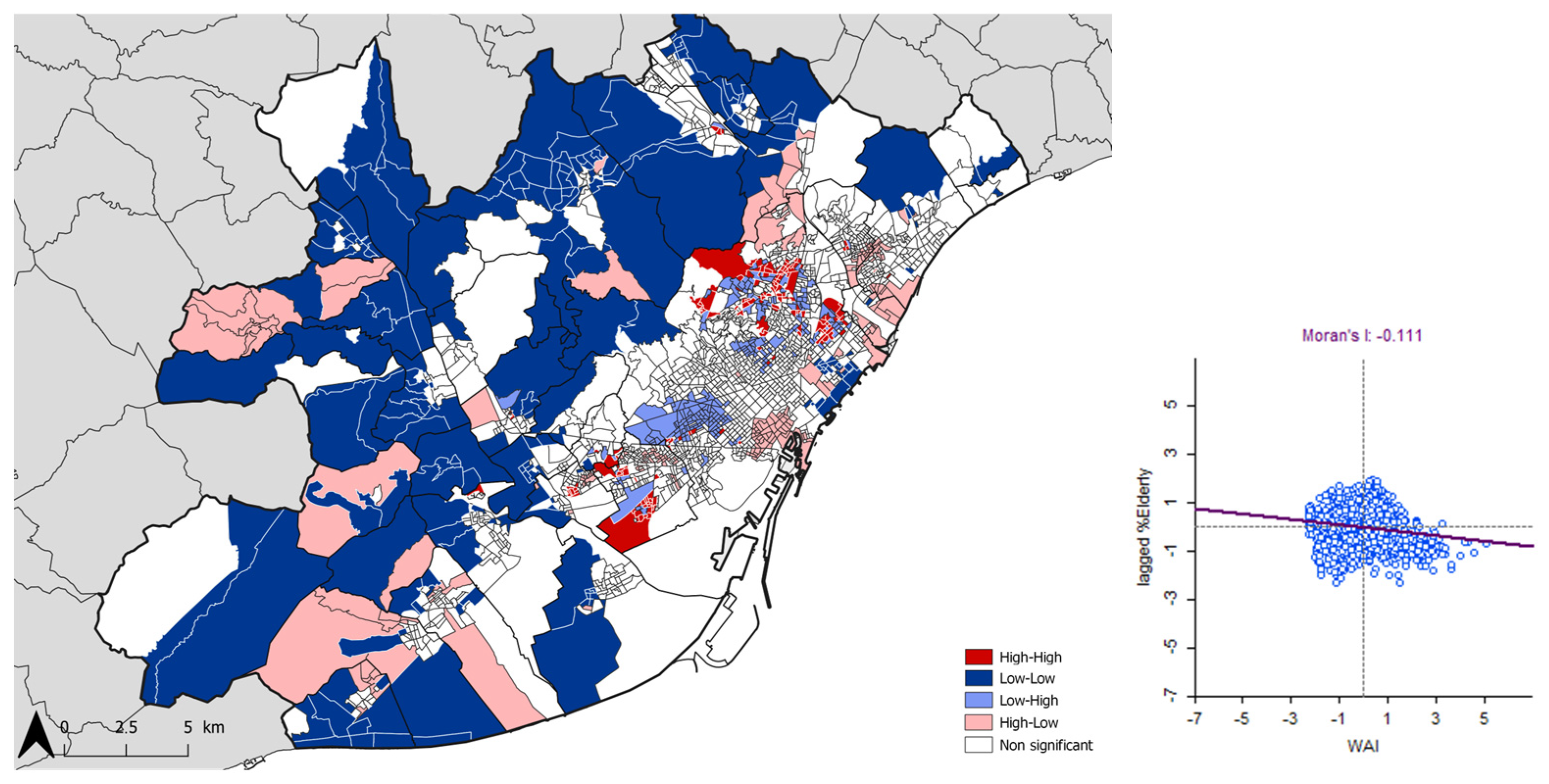
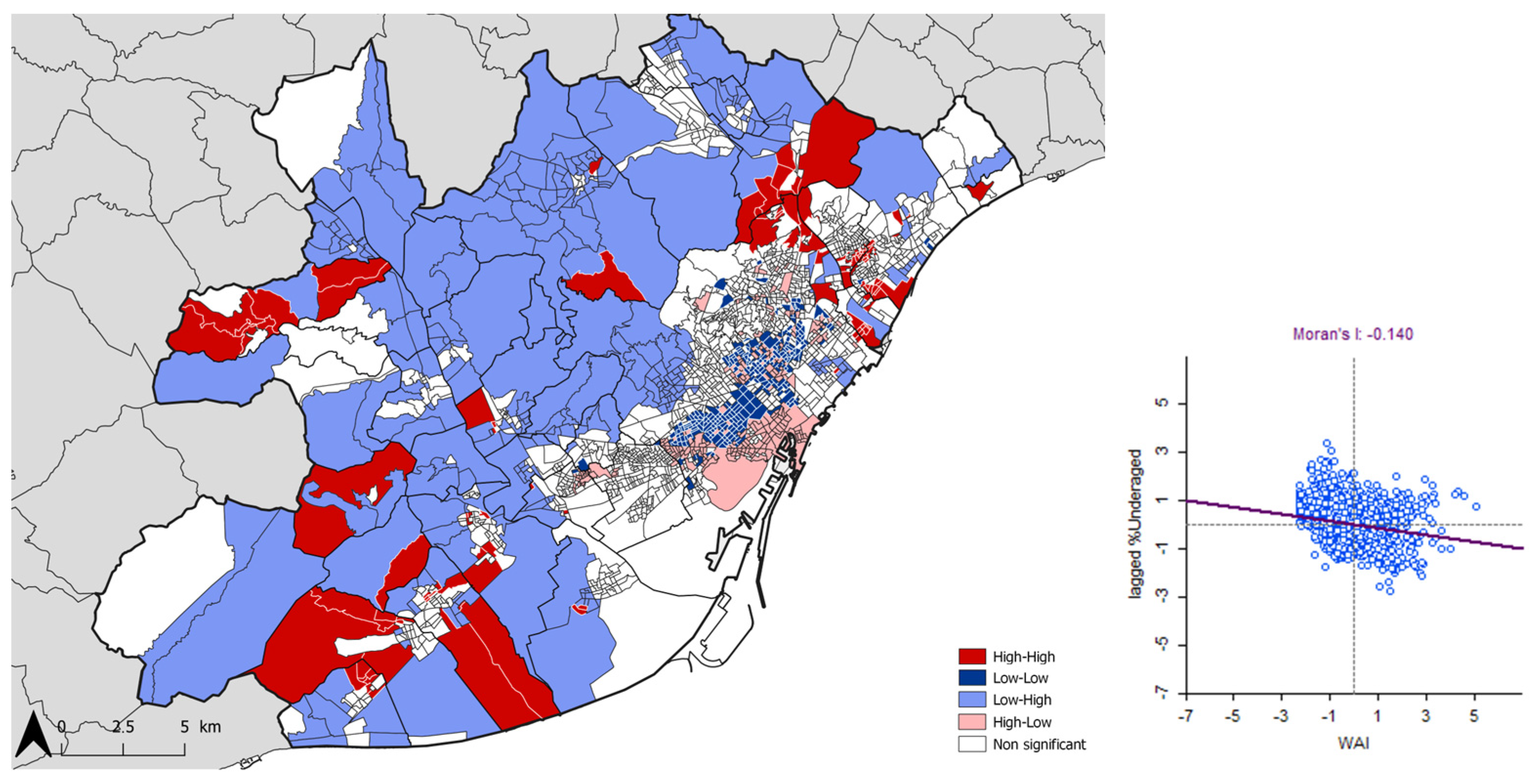
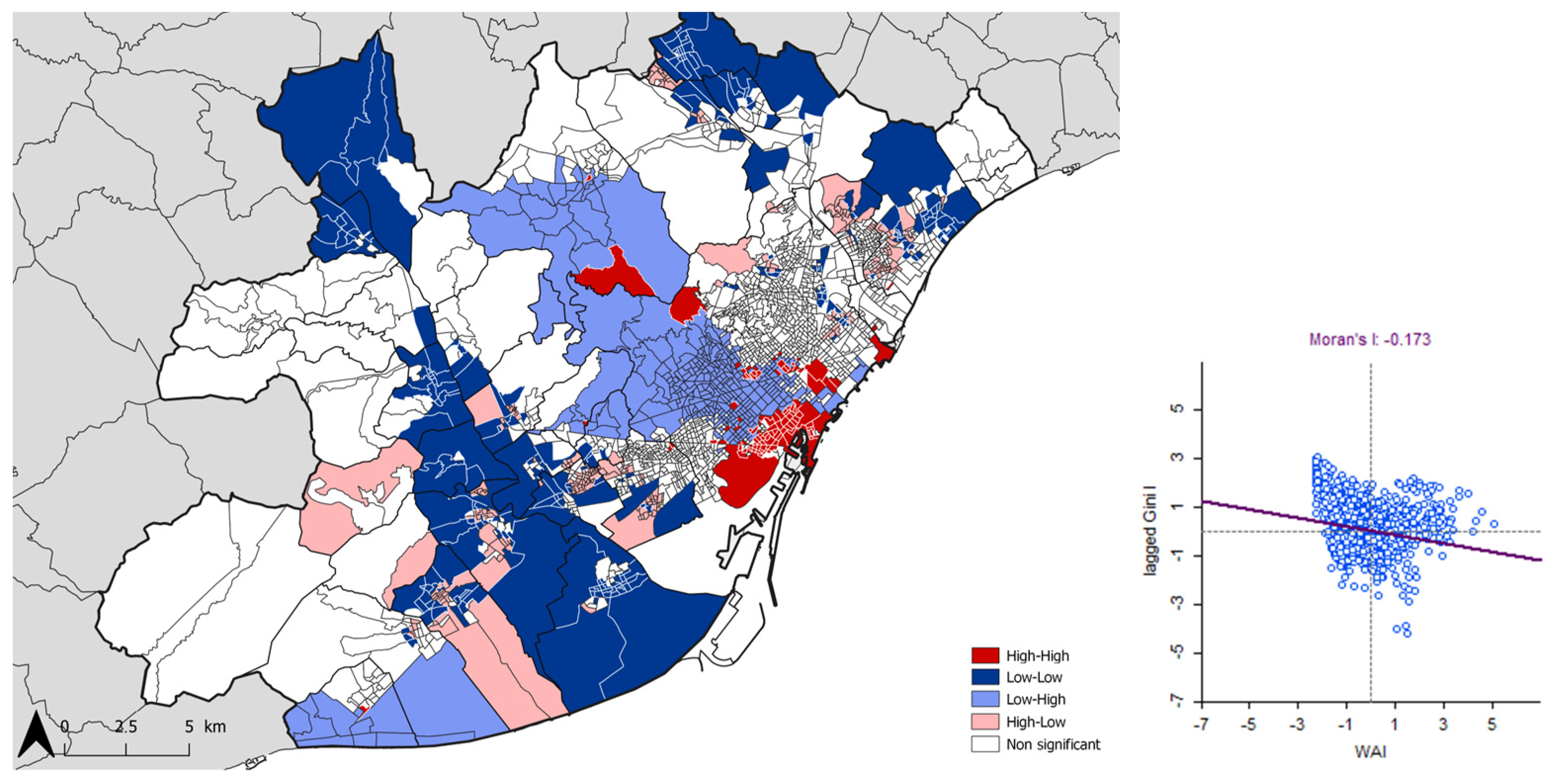
| Cluster Category | MAB CTs (%) | MAB Surface (%) | Population (Inhabitants) | Population (%) |
|---|---|---|---|---|
| High-High | 17.74 | 5.11 | 563,569 | 17.50 |
| Low-Low | 19.89 | 33.62 | 691,155 | 21.46 |
| Low-High | 0.52 | 1.87 | 19,861 | 0.62 |
| High-Low | 0.61 | 2.33 | 18,813 | 0.58 |
| Non-significant | 61.25 | 57.07 | 1,926,653 | 59.83 |
Disclaimer/Publisher’s Note: The statements, opinions and data contained in all publications are solely those of the individual author(s) and contributor(s) and not of MDPI and/or the editor(s). MDPI and/or the editor(s) disclaim responsibility for any injury to people or property resulting from any ideas, methods, instructions or products referred to in the content. |
© 2024 by the authors. Licensee MDPI, Basel, Switzerland. This article is an open access article distributed under the terms and conditions of the Creative Commons Attribution (CC BY) license (https://creativecommons.org/licenses/by/4.0/).
Share and Cite
Romero-Gomez, G.; Domene, E.; Garcia, X.; Yoon, H.; Saurí, D. Socio-Spatial Analysis of Water Affordability at Small Scales: A Needs-Based Approach. Water 2024, 16, 1496. https://doi.org/10.3390/w16111496
Romero-Gomez G, Domene E, Garcia X, Yoon H, Saurí D. Socio-Spatial Analysis of Water Affordability at Small Scales: A Needs-Based Approach. Water. 2024; 16(11):1496. https://doi.org/10.3390/w16111496
Chicago/Turabian StyleRomero-Gomez, Gustavo, Elena Domene, Xavier Garcia, Hyerim Yoon, and David Saurí. 2024. "Socio-Spatial Analysis of Water Affordability at Small Scales: A Needs-Based Approach" Water 16, no. 11: 1496. https://doi.org/10.3390/w16111496
APA StyleRomero-Gomez, G., Domene, E., Garcia, X., Yoon, H., & Saurí, D. (2024). Socio-Spatial Analysis of Water Affordability at Small Scales: A Needs-Based Approach. Water, 16(11), 1496. https://doi.org/10.3390/w16111496








